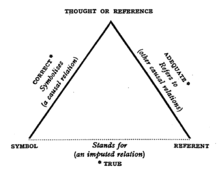
Back Semiotisches Dreieck German Semantiline kolmnurk Estonian مثلث معنا Persian Իմաստաբանական եռանկյուն Armenian Triangolo semiotico Italian Semiotische driehoek Dutch Sémantický trojuholník Slovak 語義三角 Chinese
This article has multiple issues. Please help improve it or discuss these issues on the talk page. (Learn how and when to remove these template messages)
|

The triangle of reference (also known as the triangle of meaning[1] and the semiotic triangle) is a model of how linguistic symbols relate to the objects they represent. The triangle was published in The Meaning of Meaning (1923) by Charles Kay Ogden and I. A. Richards.[2] While often referred to as the "Ogden/Richards triangle", the idea was also expressed in 1810 by Bernard Bolzano, in his Beiträge zu einer begründeteren Darstellung der Mathematik. The triangle can be traced back to 4th century BC, in Aristotle's Peri Hermeneias. The Triangle relates to the problem of universals, a philosophical debate which split ancient and medieval philosophers, especially realists and nominalists.
The triangle describes a simplified form of relationship between the speaker as the subject, a concept as an object or referent, and its designation (sign, signans).
- ^ Colin Cherry (1957) On Human Communication
- ^ C. K. Ogden and I. A. Richards (1923) The Meaning of Meaning